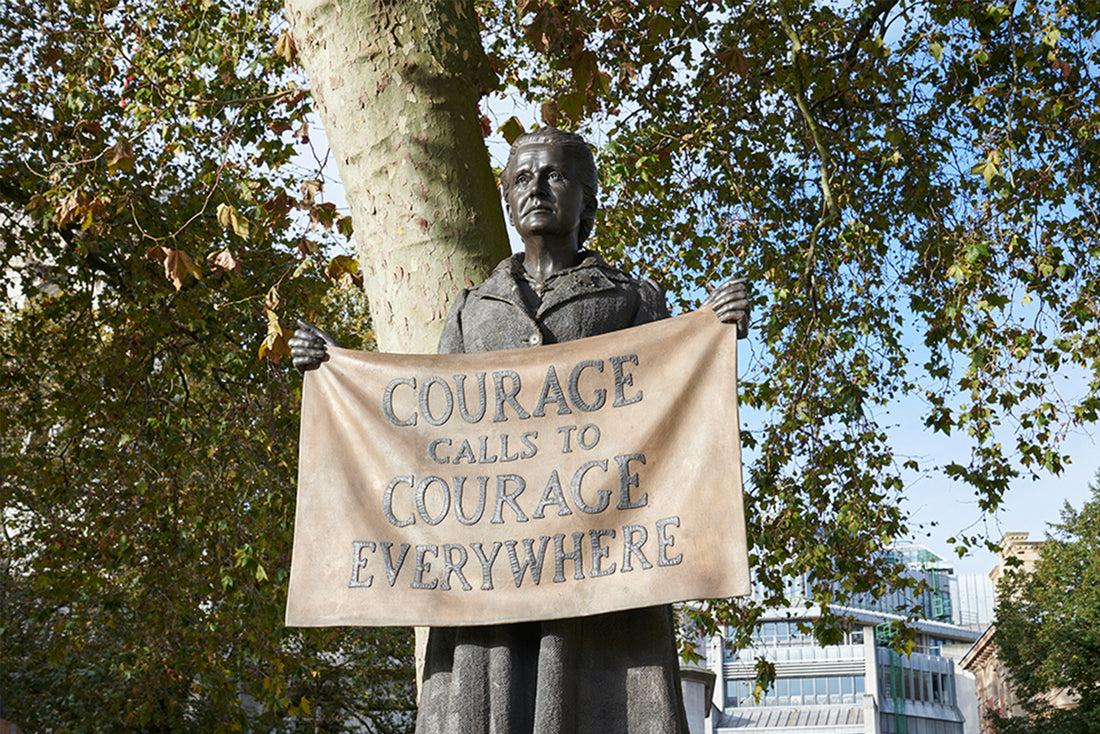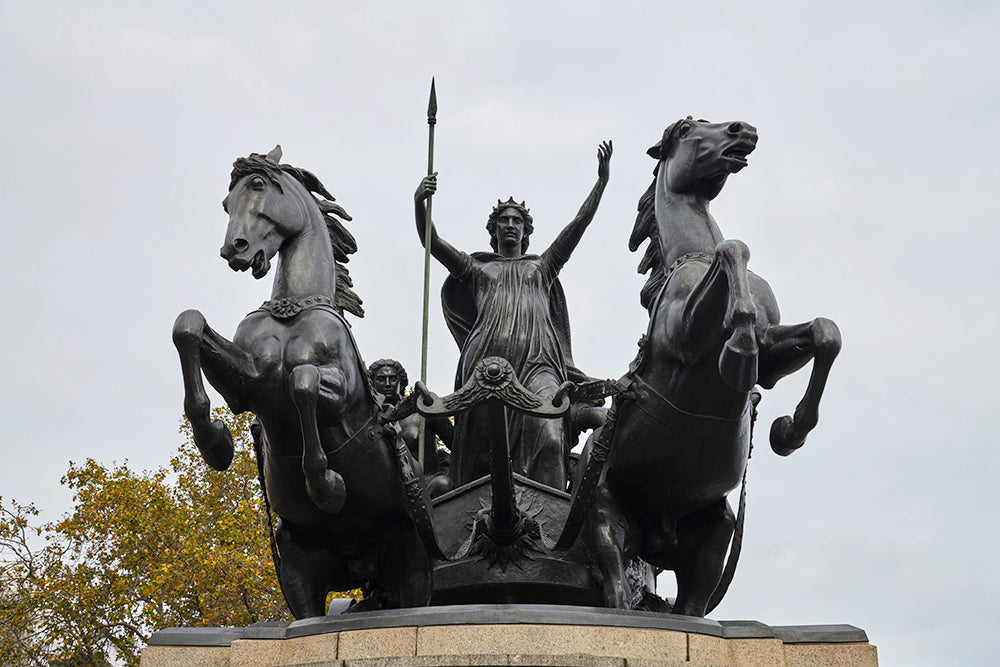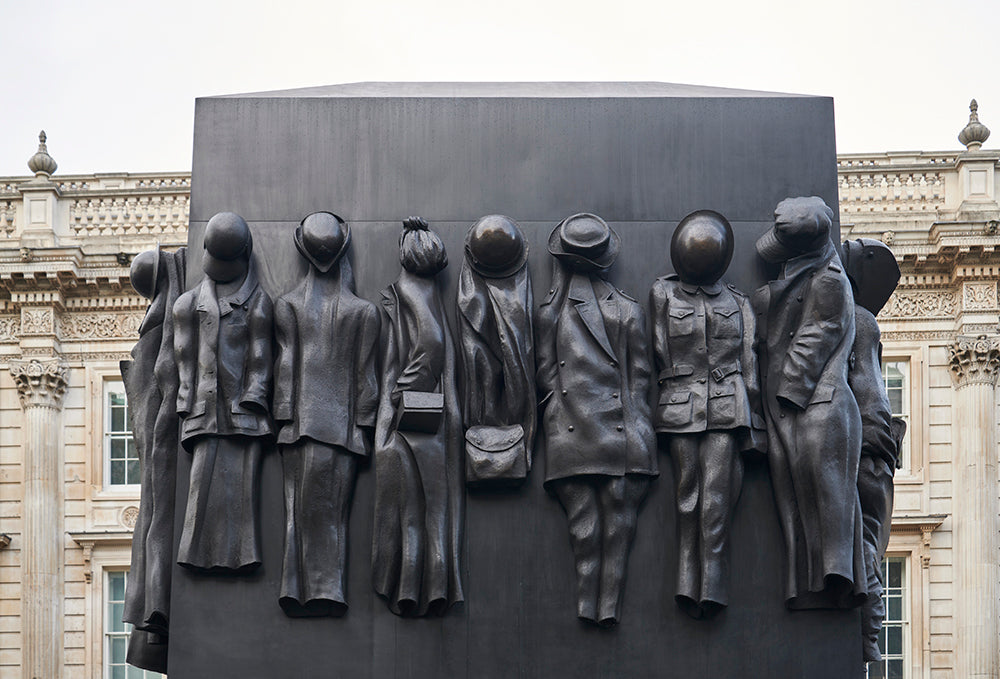
Meet the ‘Women of Westminster’ on our London walking tour
Share
To celebrate the launch of our Women’s History London Map, author and expert tour guide Katie Wignall has curated and written a walking tour of London’s Westminster, highlighting some of the fascinating women whom you can meet through statues, plaques and sculptures. Illustrated with photographs by Jo Underhill, Katie’s map is your ideal guide for exploring women’s history in London.
As a seat of politics in the United Kingdom, Westminster is a historically important area of London. Yet it’s only relatively recently that women have started to play a leading role within this realm and let’s face it, there’s still more work to be done. The statues of women marked below for this walking tour not only show the importance of women to British political history, but their gradual growth in visibility to the public in this significant part of the city.
Boudicca
The walk starts at the statue of Boudicca and her daughters, a short walk from Westminster Tube Station. Opposite the Houses of Parliament, our national seat of power, stands a statue of a woman, both arms aloft with her right hand clasped around a spear. Crouching beside her are her two daughters clutching the sides of a chariot, pulled by horses that are hurtling towards you.
This is Boudicca, married to the ruler of the Iceni tribe in Britain during the 1st century AD. When her husband died the Romans who had invaded Britain assumed they would take control of the tribe but Boudicca had other ideas. Affronted by this apparent coup, the Romans flogged Boudicca and ‘violated’ her daughters. The upper echelons of Iceni men were also stripped of their estates. Incensed by their mistreatment, Boudicca led a revolt against the Romans, first destroying Colchester, then St Albans and finally London.
The Roman historian Cassius Dio explains that “80,000 of the Romans and of their allies perished, and the island was lost to Rome. Moreover, all this ruin was brought upon the Romans by a woman, a fact which in itself caused them the greatest shame.” In the end the Romans regrouped and Boudicca’s win was short-lived. She committed suicide by poison and (though there are many rumours) it’s not known where she died and was buried.
This dynamic bronze statue was commissioned in the 1850s by Prince Albert and designed by Thomas Thornycroft. It was unveiled here in 1902.
 Boudicca statue, Victoria Embankment
Boudicca statue, Victoria Embankment
Millicent Garrett Fawcett
Walk past the Elizabeth Tower and cross into Parliament Square. Parliament Square has a number of statues of British and international statesmen but it was only in 2018 when a statue of a woman appeared.
This is Millicent Garrett Fawcett, sculpted by Gillian Wearing and unveiled in 2018 to commemorate 100 years since some women gained the vote in 1918. Fawcett is most famous as a suffragist who believed in a non-violent campaign for the vote for women. She spent almost all her life as an activist driven to improve the lives of women, writing her first published article on the importance of educating women aged 20. She lived to see the 1928 Representation of the People Act which gave the vote to women on the same basis as men.
One of the best aspects of this statue is the fact that it is not just Fawcett celebrated here. She is literally supported by the work and courage of 59 women and four men who are commemorated in photographs around the base.
Women of World War II
Exit Parliament Square onto Parliament Street and up Whitehall, the great corridor of power where once stood the Royal Palace of Whitehall but is now lined with government offices and institutions.
One of the most famous memorials along Whitehall is the Cenotaph, unveiled in 1920 to commemorate all soldiers lost in the First World War. Today it is where we remember ‘The Glorious Dead’ from all conflicts each Remembrance Day.
A short walk from the Cenotaph is a similarly shaped sculpture in dark bronze. Emblazoned across the side is “Women of World War II'' and it is decorated with clusters of uniforms. It represents the civilian and military roles taken up by over seven million women during the Second World War. One of the most famous instances was HM Queen Elizabeth II. Though only 13 when the war started in 1939, when she turned 18 she was determined to contribute and joined the Auxiliary Territorial Service (ATS) and trained as a truck driver and mechanic.
"Women of World War II" statue Whitehall
Edith Cavell
Continue up Whitehall to enter Trafalgar Square. The grand building that dominates the space is the National Gallery, our national collection of some of the finest paintings in the world. Though women are shockingly underrepresented (there are only 21 paintings by women in the collection) it is worth visiting to see works by Rachel Ruysch (1664–1750), Artemisia Gentileschi (1593–c.1652) and Élisabeth Vigée Le Brun (1755–1842).
On Charing Cross Road, pause alongside the entrance to the National Portrait Gallery to admire the statue of Edith Cavell. Born in 1865, Cavell received a good education and then worked for a governess for a Belgian family between 1890–1895. When her father was severely ill she returned home to care for him and the experience drove her to train as a nurse once he recovered.
From 1896 she worked under the formidable Eva Luckes at the London Hospital who revolutionised the training for nurses making it more rigorous and professional. Highly skilled and experienced, Edith had various positions in St Pancras and Shoreditch before moving back to Brussels from 1907. At the beginning of the First World War and despite German occupation she continued to work, helping British soldiers out of Belgium and into the Netherlands. In August 1915 she was arrested and held in prison for ten weeks, the last two in solitary confinement. She would eventually admit to helping 60 British and 15 French soldiers (as well as approximately 100 civilians) to escape.
She was executed by firing square on 12 October 1915, despite worldwide condemnation. This statue was designed by Sir George Frampton and erected only a few years after her death in 1920.
Agatha Christie
Walk up to the top of St Martin’s Lane for our final stop. This is a complicated junction of six streets, but on the corner of Cranbourn Street and Great Newport Street you can find the memorial sculpture of Agatha Christie.
Christie was born in 1890 into a wealthy family in Devon. Her big break in writing came in 1920 when the Hercule Poirot story, The Mysterious Affair at Styles was published. She would go on to write 66 detective novels and 14 short story collections, becoming arguably the best-selling novelist of all time.
Fittingly, the statue designed by Ben Twiston-Davies, is shaped like a book with a bust of Christie in the centre. It also features details of Christie’s much-loved titles so it’s fun to try and pick out her characters and symbols from some of her best-loved stories. My favourite detail is the mousetrap at the very top, a nice link to the nearby St Martin’s theatre where you can see The Mousetrap – the world’s longest running play – which opened in the West End in 1952.
Women’s History London Map
Explore London through the lens of women’s history. Our new Women’s History London Map highlights 50 statues, sculptures, blue plaques, gravestones, buildings and monuments – dedicated to women such as Millicent Garrett Fawcett, Virginia Woolf, Aphra Benn, Ada Lovelace and Phillis Wheatley. With an introduction and descriptions by Katie Wignall, author, city history tour guide and Londoner, and photography by Jo Underhill, the map guide is a companion to begin exploring the lives of some of London’s most impactful women, and to inspire the next generation to continue their work.
The map is available in bookstores or from our website here.

